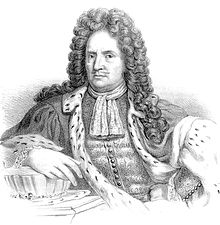Erik Dahlberg

Erik Jonsson Count von Dahlberg (born October 10, 1625 in Stockholm ; † January 16, 1703 ibid) was a Swedish field marshal , architect and fortress builder. His artistically remarkable drawings for a large-scale copperplate engraving with views of Swedish places are of high topographical and architectural historical value.
Life
From 1646 Dahlberg acted as a clerk at the Pomeranian Chamber and in 1647 was commissioned to investigate all Swedish fortresses in Pomerania , Brandenburg , Mecklenburg , Bremen and Westphalia . 1650–1654 he took lessons in perspective and fortification theory from Georg Andreas Böckler in Frankfurt am Main , then he studied art and architecture in Italy. Ordered back into the Swedish army in 1656 , he built new fortifications as an engineer and distinguished himself in the Second Northern War against Poland and Denmark in such a way that he received the position of lieutenant colonel and the nobility diploma in 1660 and quickly rose to higher dignities. At the same time, the first drawings for copper engravings in Samuel von Pufendorf's story of King Carl X. Gustav of Sweden (only published in 1696/97) were made. With a royal privilege , work on his main work began in 1661, a large geographical and historical depiction of the Swedish territories. 1667–1668 he traveled to Paris to have the first plates engraved for it. This work was temporarily suspended when in 1674 he was entrusted with responsibility for all Swedish fortress construction. It was not until 1684 that he continued work on the topography, now as the official publisher on behalf of the government. He continued his career in civil administration, in 1687 he became governor ( Landshövding ) in Jönköping , in 1693 Swedish imperial count, field marshal and governor general of the duchies of Bremen and Verden and in 1696 of Livonia . In 1700 he defended Riga against Saxon Poland in the Great Northern War , resigned in 1702 when Charles XII. attacked Poland against his will and died in Stockholm on January 16, 1703. Because of his services to improve the fortress construction in Sweden, he was called the "Vauban of Sweden".
His main work, Suecia antiqua et hodierna , was first published in Stockholm in 1716 in three plate volumes with 354 copperplate engravings on 321 partly folded plates and with 13 pages of indexes. The text part never got beyond the introduction, and the planned fourth volume with the views from the conquered areas was not published as a copperplate engraving. New editions and facsimile prints followed several times. The rare and magnificent work of views of Sweden's cities, ports, castles, remarkable buildings, but also Old Norse sites and monuments from Sweden and Finland is an important testimony to the elaborate building projects of the crown and the nobility after the great wars. In the representations of individual buildings and gardens, he often follows French and Dutch patterns, while the city views are based on Merian's example .
Works
Fortifications
- Nienburg Fortress , from 1639
- In 1684 he revised the plans for the unfinished fortress town of Carlsburg at the mouth of the Weser, but could not prevent the project from failing.
- Bastions in Arensburg (Estonia), after 1675
- City fortifications of Riga , planned in 1681, executed in 1684 ff.
- Wismar city fortifications , from 1681,
- City fortifications of Karlskrona , 1683–1687
- Carlsten fortress near Marstrand , 1683,
- Drottningskär Fortress near Karlskrona , 1694
- Gothenburg , Kruthustorget, Castle "The Lion", 1689
- Gothenburg, Skanstorget, Fort "Die Krone", 1697 (today military museum)
- Ichnographia Helsingoræ et Arcis Croneburgensis Quæ, 1729 digitized
Church and secular buildings
- Karlskrona, Admiralty Church Ulrika Pia, 1685 (attribution)
- Floda , burial chapel for Field Marshal Lars Kagg, 1666,
- Turinge , burial chapel for himself, after 1681
- Askersund , Soop burial chapel, after 1665
- Gothenburg, Christinakirche, Rutger Acheberg burial chapel, 1682
- Jönköping , Braheschule, 1695
- Jönköping, Västra Chapel, 1694, wooden structure
- Pärnu (Estonia), Tallinn Gate
Urban planning projects
- Landskrona, ideal city project , 1680
- Narva , expansion plan, 1686
Web links
- Accurata delineatio Castrorum Suecicorum, ut et Haffniæ, Regni Daniæ Metropolis . Riegel, Norimbergae 1729 ( digitized version ), as well as another 90 copper engravings
- Suecia antiqua - digitized version of the Stockholm National Library
Individual evidence
- ↑ See, however, the publication by Wallin
literature
- Thieme-Becker: General Artists Dictionary , Vol. 8, p. 276
- LO Larsson: Dahlbergh, Erik , in: Saur Allgemeines Künstler-Lexikon, Munich 1999, pp. 421-422.
- S. Wallin: Erik Dahlbergh, Teckningarna till Svecia antiqua et hodierna , 4 volumes, Stockholm 1963–1970 (also facsimiles of the previously unprinted drawings).
| personal data | |
|---|---|
| SURNAME | Dahlberg, Erik |
| ALTERNATIVE NAMES | Dahlberg, Erik Jonsson Count of |
| BRIEF DESCRIPTION | Swedish field marshal |
| DATE OF BIRTH | October 10, 1625 |
| PLACE OF BIRTH | Stockholm |
| DATE OF DEATH | January 16, 1703 |
| Place of death | Stockholm |
